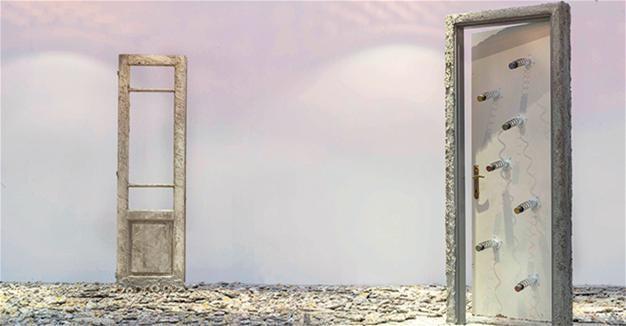Exhibition sets about constructing a home
Hatice Utkan Özden
 In her book, “The Encyclopedia of Trouble and Spaciousness,” Rebecca Solnit writes about homes and how they change the way we live and how they become the stage that set for the drama we hope our lives will be or become. In short, for Solnit, the home is not just a place that keeps us warm, it signifies much more.
In her book, “The Encyclopedia of Trouble and Spaciousness,” Rebecca Solnit writes about homes and how they change the way we live and how they become the stage that set for the drama we hope our lives will be or become. In short, for Solnit, the home is not just a place that keeps us warm, it signifies much more.Solnit sees home as a place or a ref-uge that has a deep connection to people and how they define themselves. In her latest ex-hibition, curated by Hasan Bülent Kahmraman at Galeri Has, artist Eda Soylu also refers to home as a shelter, a refuge and a place to which one owes his or her existence.
In her installation that depicts a home, Soylu uses broken bricks, broken doors and win-dow frames; by doing so, she aims to destroy her home. She constructs a new home by de-stroying it again and again. For her, home is directly connected to the self. “Home repre-sents the self. Home is something and everything that we dwell in. If we look at it from this perspective, even our bodies can be considered a home, a temporary one maybe, but it houses our souls and minds,” she said, adding that one can be at home just by being.
Soylu is an artist who likes to open a new dimension of thought for her viewers. While she approaches the idea of home (constructing and destroying it) she also sees home as a place directly connected to one’s experiences and where memories are obtained. According to her, home carries traces from outside, but it is inevitable to see traces of outside and of our given surroundings reflecting on to our chosen surroundings. “A home, whatever that is – changes from person to person, carries embedded observations,” she added.
Depicting home in his writing for the exhibition framework, curator Hasan Bülent Kahraman wrote that home is a shelter and a human being is identified with a shel-ter/refuge. From the moment one comes to life and leaves it or goes beyond it, one owes their existence to that shelter. The similarities and oppositions between the mother’s womb and the tomb is the summary of a human being’s existence on earth and the cultural adven-ture that surrounds one all through. In a world that starts and ends with dependence, hu-mans express their existence with their homes.
The notion of home in Soylu’s installation may also stand as a political or a socio-political question that entangles with the concept of migration, how the living is with or without home, and seeing others living like that affects us. The broken bricks filled with flowers and colored concrete-filled forms loaded with springs, which Soylu was inspired by, may be a reminder of a political stance on migration and war.
Belonging to a society
There is no doubt that Soylu’s interactive installation makes people question home and its environs. It is a fact that home also refers to society. However, according to Soylu, home is not a status determiner in a society. It decreases the importance of the meaning, of the def-inition of a home, if and when we consider it that way. It is not that simple.
“There are so many with huge houses, who do not feel at home. One does not have to have a house – in its most literal sense, to have a home. The notion of home is not some-thing that can only be bought with money. It comes with words such as intimacy, sincerity, warmth, traces, memories and experiences,” she said.
“For some, home is a person, a person becomes their home, for some it is a square body, triangular roof building and for some it is only the drawing of it,” Soylu said, adding that on one hand, for some, home is memories, for Bachelard it is a drawer and for some it is only a photograph.
The exhibition will continue until Jan. 13, 2017.
















